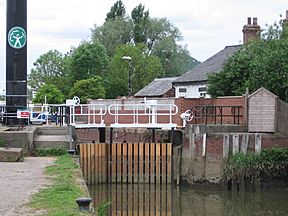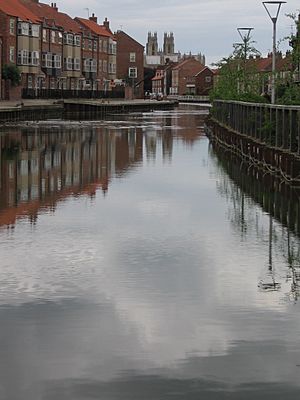Beverley Beck facts for kids
Beverley Beck is a short waterway in the East Riding of Yorkshire, England. It's like a small canal that connects the town of Beverley to the River Hull. The beck stretches about 0.8 miles (1.3 km) from Grovehill Lock on the River Hull into Beverley. For a long time, the water level in the beck changed with the tides. But in 1802, a special lock was built. This lock helped keep the water level steady, especially when a drain needed to pass underneath the beck. Later, in 1898, a steam engine was added. This engine could pump water from the River Hull to keep the beck full. The whole area got a big makeover in 2007. This included fixing the lock gates and the old pumping engine.
Contents
History of Beverley Beck
The first mention of Beverley Beck was in 1296. At that time, people wanted to remove fish traps from the River Hull. This would allow boats to reach Beverley more easily. A place called Grovehill, near the River Hull, was used for boats to tie up. By 1344, boats could travel all the way to Beverley. Records from that year show that the beck was being cleaned.
Early Management of the Beck
The town leaders, called the Beverley Corporation, thought they controlled the waterway. They rented it out to people who had to provide boats for carrying goods. Later, in 1704, they started charging tolls instead. This meant other boats could use the beck too. The old mooring spot at Grovehill was eventually turned into a lock.
During the 1600s, there were many tries to improve the beck by cleaning it. But finding money for these projects was always a challenge. In 1695, a group of town officials was chosen to collect money for maintenance. In the 1720s, a man named John Warburton suggested using a special boat to loosen reeds and mud. He also thought two locks could hold back water at high tide. This water could then be released at low tide to wash away the dirt.
Laws and Improvements
In 1726, the Corporation needed more money for repairs. So, they asked for a special law from Parliament. This law, passed in 1727, allowed them to clean, widen, and deepen the beck. It also let them fix the wharves (places where boats load and unload) and roads. They could also charge more tolls. A civil engineer named William Palmer helped with the work. It was finished in 1731, but it didn't improve things much.
Another law was passed in 1744. This one aimed to make the beck even better. It also changed how tolls were collected. The amount charged now depended on the value of the goods being carried. The Corporation kept cleaning the beck, mostly by dredging (removing mud). From 1748, they hired someone else to collect the tolls for them.
The Lock and Trade Growth
A big change happened in 1802. A new drain, called the Beverley and Barmston Drain, was being built. This drain needed to go under the beck. The engineer for the drain, William Chapman, suggested building a lock. This lock would keep the water level steady over the tunnel for the drain. The town leaders agreed, and Chapman designed the lock. It cost about £817 to build.
Even though a railway came to Beverley in 1846, the beck stayed busy. It helped keep transport costs low. Traffic on the beck grew a lot. In 1838, about 31,185 tonnes of goods were carried. By 1905, this had grown to 101,540 tonnes! In 1898, a steam engine and pump were installed. This helped raise water from the River Hull into the beck.
At first, men often pulled the boats along the beck. Later, powered boats, called keels, started using the waterway. Grovehill Lock was rebuilt in 1958. It could now handle boats up to 65 by 17.5 feet (19.8 by 5.3 m) in size. Commercial boats continued to use the beck until quite recently. In 1970, they carried over 28,000 tonnes of cargo, mostly coal and animal feed.
Beverley Beck Today
Beverley Beck was built to help larger boats reach the growing town of Beverley. Today, it's a popular spot for leisure boats. It's also home to a historic barge called Syntan. This barge was built for a tannery (a place that makes leather) in Beverley. It was based on the beck from 1949 until the 1970s. After some time away, a group bought its remains in 2001 and spent three years restoring it.
The beck is also a great place for fishing. You can find large pike, along with bream, dace, eel, gudgeon, and tench. The Beverley Beck Boating Association also has its home here, and many of its members keep their boats on the beck.
Modern Improvements
The beck has seen some big improvements. A major dredging project finished in April 2004. Dredging means removing mud and dirt from the bottom. Before the work, tests showed high levels of metals and other chemicals in the mud. These came from old factories. So, the mud had to be taken to a special hazardous waste site. The company doing the work used a new system to separate the dangerous waste from the regular mud. This was the first time such a system was used on an inland waterway.
In 2005, a big project began to improve the beck and the area around it. The final part of this project started in 2007 and cost £250,000. It involved fixing the lock gates and the pumping station. New footpaths and cycle routes were also built. The previous lock gates had been put in place in 1953.
Course of the Beck
- Situated on the River Hull
- Next place upstream = Arram Beck
| Point | Coordinates (Links to map resources) |
OS Grid Ref | Notes |
|---|---|---|---|
| Beverley | 53°50′20″N 0°24′47″W / 53.839°N 0.413°W | TA044392 | Head of navigation |
| Grovehill Lock | 53°50′24″N 0°23′42″W / 53.840°N 0.395°W | TA057393 | Junction with River Hull |



